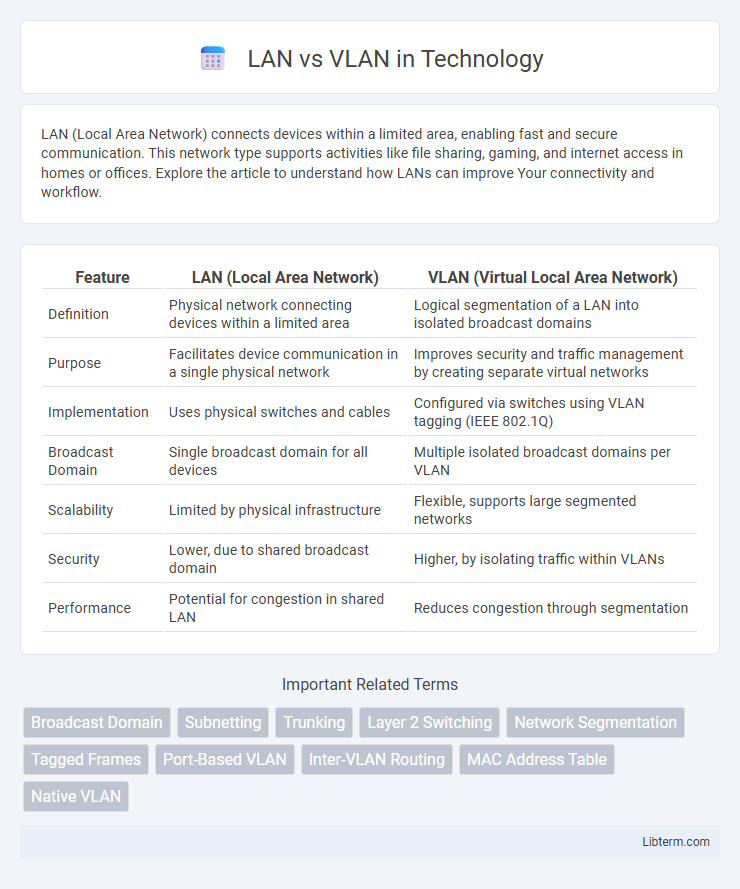LAN (Local Area Network) connects devices within a limited area, enabling fast and secure communication. This network type supports activities like file sharing, gaming, and internet access in homes or offices. Explore the article to understand how LANs can improve Your connectivity and workflow.
Table of Comparison
| Feature | LAN (Local Area Network) | VLAN (Virtual Local Area Network) |
|---|---|---|
| Definition | Physical network connecting devices within a limited area | Logical segmentation of a LAN into isolated broadcast domains |
| Purpose | Facilitates device communication in a single physical network | Improves security and traffic management by creating separate virtual networks |
| Implementation | Uses physical switches and cables | Configured via switches using VLAN tagging (IEEE 802.1Q) |
| Broadcast Domain | Single broadcast domain for all devices | Multiple isolated broadcast domains per VLAN |
| Scalability | Limited by physical infrastructure | Flexible, supports large segmented networks |
| Security | Lower, due to shared broadcast domain | Higher, by isolating traffic within VLANs |
| Performance | Potential for congestion in shared LAN | Reduces congestion through segmentation |
Introduction to LAN and VLAN
A Local Area Network (LAN) connects computers and devices within a limited area, such as an office or home, enabling resource sharing and communication. A Virtual LAN (VLAN) segments a LAN into multiple distinct broadcast domains, improving network performance and security by isolating groups of devices logically rather than physically. VLANs enhance network management by allowing administrators to group users based on function, department, or project regardless of their physical location.
What is a LAN?
A Local Area Network (LAN) is a network that connects computers and devices within a limited geographic area such as a home, office, or building, enabling high-speed data transfer and resource sharing. LANs typically use Ethernet or Wi-Fi technologies to facilitate communication between connected devices. Unlike VLANs, which segment a LAN into separate virtual networks, a LAN operates as a single unified network layer.
What is a VLAN?
A VLAN (Virtual Local Area Network) is a logical subgroup within a LAN that segments a larger physical network into smaller, isolated networks to improve security and reduce broadcast traffic. It operates at the data link layer (Layer 2) using VLAN IDs to separate traffic, allowing devices on the same physical network to communicate as if they are on different LANs. VLANs enhance network management by enabling better control over traffic flow, simplifying network redesigns, and increasing flexibility in assigning devices to specific groups without changing the physical infrastructure.
Key Differences Between LAN and VLAN
A LAN (Local Area Network) connects devices within a limited physical area, such as a home or office, enabling direct communication over shared hardware. A VLAN (Virtual Local Area Network) segments a single physical LAN into multiple logical networks, improving security and traffic management by isolating groups of devices regardless of their physical location. Key differences include that LANs are hardware-dependent with broadcast traffic confined to physical segments, while VLANs use software-defined boundaries to control traffic flow and enhance network scalability.
Benefits of Using VLAN over LAN
VLANs provide enhanced network segmentation compared to traditional LANs, improving security by isolating sensitive data and reducing broadcast domains. They optimize network performance by minimizing congestion and allowing better traffic management through logical grouping of devices regardless of physical location. VLANs also offer greater flexibility in network design, simplifying administration and enabling scalable, efficient resource allocation.
Security Features: LAN vs VLAN
VLANs enhance network security by segmenting devices into separate broadcast domains, limiting unauthorized access and reducing the risk of data breaches compared to traditional LANs. LANs typically allow all devices within the same physical network to communicate directly, increasing vulnerability to internal attacks. VLANs support advanced security features like access control lists (ACLs) and network traffic filtering, providing granular control over inter-device communication.
Network Efficiency and Performance
LANs connect devices within a single physical network, leading to potential broadcast traffic congestion that can reduce overall network efficiency. VLANs segment a LAN into multiple virtual networks, effectively isolating broadcast domains and reducing unnecessary traffic, which enhances network performance. This segmentation allows for better bandwidth management and improved security while optimizing resource utilization across the network.
Scalability and Flexibility
VLANs offer superior scalability compared to traditional LANs by allowing network administrators to segment large physical networks into multiple logical networks, reducing broadcast traffic and enhancing performance. VLANs provide enhanced flexibility by enabling dynamic grouping of devices across different physical locations without requiring re-cabling, which simplifies network management and supports evolving organizational needs. LANs, while simpler, lack this level of adaptability, making VLANs the preferred choice for growing or complex network environments.
Common Use Cases for LAN and VLAN
LANs (Local Area Networks) are commonly used to connect devices within a single physical location, such as homes, offices, or schools, facilitating high-speed data sharing and resource access. VLANs (Virtual Local Area Networks) enable network segmentation within the same physical infrastructure, improving security and traffic management by isolating groups of users or devices based on function, department, or project. Enterprises frequently deploy VLANs to separate voice, data, and management traffic while LANs support everyday connectivity needs for desktops, printers, and servers.
Choosing the Right Network Solution
Choosing the right network solution involves understanding the differences between LAN and VLAN technologies. LAN provides localized connectivity within a single physical network, ideal for small, straightforward setups with minimal segmentation needs. VLAN offers enhanced network management by logically segmenting a physical LAN into multiple virtual networks, improving security, reducing broadcast traffic, and optimizing resource allocation in complex or large-scale environments.
LAN Infographic

 libterm.com
libterm.com